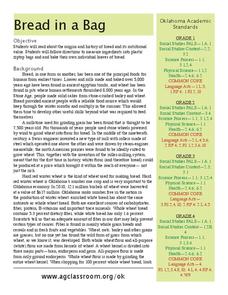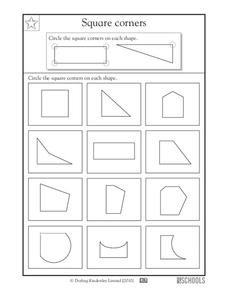Curated OER
Problems with Measures
Yards or inches? Understanding measurements has a lot to do with units, so give scholars some scenarios and have them choose the appropriate unit. There are six labeled images here requiring weight, distance, length, and capacity. They...
Curated OER
Fact Families - Part 3
These fact family equations need to be completed, and there are 56 here to give scholars plenty of practice! They write in sums and differences for eight 3-number fact families and four 2-number fact families. The problems are scaffolded...
Curated OER
Bread in a Bag
Could the history of bread really be interesting? Yes, it could! An informational text gives scholars wheat production background from 8,000 years ago, discussing different types of bread and the current industry in Oklahoma. Learners...
Curated OER
Addition Drills, part 3
Here's an addition drill for scholars who are already comfortable with regrouping. There are 30 horizontally-aligned problems here, each with two 2-digit addends. Mathematicians use three examples as reference as they solve each of...
Curated OER
Draw the Other Half
How can you make the two halves symetric? Scholars use the concept of symmetry to complete five images which are only half-drawn. The fun part about this exercise is that they aren't copying geometric shapes. There is a face, sun, kite,...
Curated OER
Sets Of
Represent multiplication as sets of items for beginners to this concept. They look at six familiar object sets and determine the total number of legs by counting the sets. There is some scaffolding here, as the first is done for them and...
Curated OER
Working with Money
How much money do you have? Scholars add up dollars and cents to get totals for 12 visual addition problems. They look at pictures of the currency and write the total numerically (remember that dollar sign). Although the coin images look...
Curated OER
Hopping by 2s, part 2
Explore skip counting by twos with young mathematicians as they complete these engaging activities. First, they color in squares to represent counting by twos in an even sequence and an odd sequence. Next, they connect dots (by twos) to...
Curated OER
Money
Converting money is both practical and an excellent gateway into future math concepts, and scholars get plenty of practice here! There are four sections, each with 12 values for them to convert. First, they change cent values into...
Curated OER
Symmetry
Do these dotted lines indicate symmetry? Some of them do, and scholars determine which ones in 12 different images. Because some of these are tricky, it may be helpful to have large versions of these shapes printed and cut out. This way,...
Curated OER
Fractions of Shapes
Fraction models are a great way to help scholars visualize this concept, and they focus on thirds with these practice problems. First, there are five shapes each segmented into three even sections. Learners color in one-third of each,...
Curated OER
Fact Families
With a few extra numbers, these fact families would be complete! After looking at an example, scholars write in the sums and differences for six equations as part of three different fact families. This is really for beginners to this...
Curated OER
Sorting 2-Dimensional Shapes
Explore shape attributes with young geometers as they sort nine shapes based on their corners. Scholars determine whether or not each shape has a square corner, drawing it in the appropriate space accordingly. They are encouraged to use...
Curated OER
Square Corners
Which ones are square corners? As they learn more about shape attributes, be sure scholars understand the difference between a vertex and a square corner. After examining two examples, learners circle the 90-degree corners in 12...
Curated OER
Addition Practice #1
Show young mathematicians that they are fully capable of mentally adding two-digit numbers. They start by solving 12 two-addend problems (all with two-digit numbers and aligned horizontally). There is no room to show work. Consider...
Curated OER
Place Value
Each digit holds a specific value in numbers, and understanding place value is the key to this concept. Youngsters examine eight numbers and determine the value of four in each, writing it in both number and word form. Next, they circle...
Curated OER
Halves and Fourths
Young mathematicians may not love fractions, but do they love sandwiches? How about cake? Use this visual fractions activity to represent fractions in a relatable way. Scholars start by coloring segmented shapes to indicate halves and...
Curated OER
Comparing
Practice the comparison words lighter, heavier, longer, shorter, smaller, and bigger using this visual chart. For each set of three objects, pupils order them according to one of these terms. The six terms are illustrated...
Curated OER
Get in Shape with Geometry
Using geoboards, computer programs, and hands-on manipulative materials, elementary schoolers engage in a study of two and three-dimensional geometric shapes. This lesson is chock full of good teaching ideas on the subject, and the...
Curated OER
Yummy Math
Young mathematicians use bags of Skittles to help them gain practice in graphing and organizing data. They work in pairs, and after they have counted and organized their Skittles, they access a computer program which allows them to print...
Curated OER
M&M Graphing
Youngsters sort M & M's by color. They graph the M&M's by color on a graph. This classic lesson is a wonderful way to introduce the concept and technique of graphing to young mathematicians. Pairs of kids can make up their own...
Curated OER
Sorting 3-Dimensional Shapes
Three-dimensional shapes can be categorized based on their attributes, and scholars learn more about six figures through this sorting activity. They examine six shapes: sphere, cylinder, cone, cube, prism, and pyramid....
Curated OER
2-Dimensional Shapes: Drawing Shapes
Some of the best practice with shape identification comes from drawing the figures first-hand. Young geometers draw nine two-dimensional shapes: rectangle, circle, square, pentagon, hexagon, octagon, triangle with three equal sides,...
Curated OER
Calculating Change
Before beginning this money math activity, discuss with scholars why calculating change is an important life skill. They examine the prices for fruit on a snack menu and observe three customer scenarios. For each one, scholars determine...























